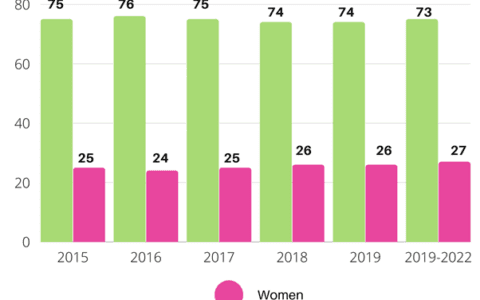The Gender Pay Gap in STEM

Since gender pay gap reporting became mandatory for large employers (over 250 staff) in 2017, the average gender pay gap for full time employees has steadily dropped over the years.
However, for many STEM industries, the pay gap still remains worryingly high, highlighting that more must be done to reach pay parity.
What is the gender pay gap?
In April 2017, the government made it mandatory for large organisations with over 250 employees to report on their gender pay gap. A gender pay gap is the average difference between the salary of male and female employees.
Companies must publish their gender pay gap data in six different ways, plus a written statement on their websites, which will also appear on the government website. When it was first introduced, the gender pay gap reports were hailed as something that could do more to progress pay parity in five years than legislations had managed to achieve in almost half a century, since the launch of the Equal Pay Act in 1970.
How has the gender pay gap changed over the years?
When gender pay gap reporting was first introduced in 2017, almost 90% of women were working for companies that paid them less than their male colleagues. In 9 out of 17 sectors, men were earning 10% more on average compared to women. The most shocking statistics emerged in construction, financial and insurance services, with men earning between 20 and 23% more than women. However, it was banks that faced the harshest scrutiny, with pay differentials as high as 43% for some employers.
However, since the reporting became mandatory, many industries have seen their pay gaps drop. The average pay gap for all employees in the UK began at 18%, it 2020 this figure fell to 15.5%. Among full-time employees, the gender pay gap in April 2020 was 7.4%, down from 9% in April 2019.
When we look closer at the type of roles employees hold, higher earners typically experience a much larger difference in hourly pay between the sexes, compared with lower paid employees. Age also comes into to it, as noted from 2018, for age groups under 40 years, the gender pay gap for full-time employees is now very close to zero. However, from age groups between 40 and 49 years and older, the pay gap is over 10%.
According to the ONS, their 2019 analysis of pay gap data which explored the types of roles in which men and women work, by age group, found that there is a lower incidence of women moving into higher-paid managerial occupations after the age of 39 years. This is usually when pay in these occupations increases.
However, managers, directors and senior officials have seen the greatest decrease, falling from 15.5% to 9%. This could reflect an increase in the number of women holding higher-paid managerial roles in 2020. This occupation group has the highest median pay of any occupation (£21.90 per hour, excluding overtime, compared with £15.07 among all employee jobs) and therefore has a strong impact on the gender pay gap.
The Gender Pay Gap and COVID-19
The data collected for the most recent gender pay gap relate to the pay period covering 22nd April, at which point around 8.8 million employees were furloughed under the Coronavirus Job Retention Scheme (CJRS). This means that potentially half of these employees only received 80% of their normal pay.
This has the potential to artificially impact the data and estimates for 2020. If a greater proportion of men than women (or visa versa) were furloughed with reduced pay, the gender pay gap estimates are more likely to reflect short term labour market conditions, rather than underlying pay trends.
The Gender Pay Gap in STEM
When we look specifically at the gender pay gap in STEM industries, professions such as Production managers in mining and energy, IT engineers, electronic technicians and financial institution managers and directors still have a pay gap of over 30%.
Professions like Quantity surveyors, economists, and chemical process operatives still have around a 20% pay gap.
The lower half is made up of design and development engineers, biological scientists, IT specialist managers and business analysts, which range from 17% – 0% pay gap.
Gender pay gap by sectors
A snapshot of the highest to lowest professions in STEM
- Production managers and directors in mining and energy – 37%
- IT engineers – 36%
- Electrical and electronics technicians – 33%
- Financial institution managers and directors – 32%
- Financial managers and directors – 28%
- Chemical and related process operatives – 26%
- Quantity surveyors – 23%
- Actuaries, economists and statistician – 21%
- Engineering technicians – 21%
- Construction and building trades supervisors – 17%
- IT business analysts, architects and system designers – 17%
- IT specialist managers – 11%
- Biological scientists and biochemists – 8%
- Electrical engineers – 7%
- Design and development engineers – 0%
As the data shows, there is still a lot of work to be done to lower the gender pay gap in many industries across STEM.
STEM Women
At STEM Women we are passionate about addressing the gender imbalance in STEM. As part of our mission we recently surveyed 265 female STEM students across 2019 and 2020 with the aim of understanding the reasons why young women choose certain career paths and the hurdles they may come up against during their job search.
One of the key themes our whitepaper covers is views towards the gender pay gap and how it may impact which roles young women apply for.
In 2019, we asked if respondents would expect to read the gender pay gap report of a company when researching roles, 65% answered yes.
“I expect at least a break down by gender of the current workforce, as well as strong policies about equal pay and opportunities.” – Catarina, Business Analytics, Tu Dublin
Many of the students also felt strongly about aligning the company values with their world views and that they would choose a certain company over another due to their equal pay policies.
“Being a woman, it is important to me that I associate myself with a corporation that reflects me.” -Rama Panchanadibal, MSc Gender and International Relations, University of Bristol
In 2020, we asked the same question and saw a complete shift in responses. Just 35% of respondents said they would expect to read the gender pay gap reports of a company when researching, with 65% saying they would not.
Due to the coronavirus outbreak, the Government Equalities Office (GEO) and the Equality and Human Rights Commission (EHRC) decided to suspend enforcement of the gender pay gap deadlines for 2019-2020.
This could explain why the number of students who would expect to read gender pay gaps fell in 2020. The majority of respondents who said they would not read the gender pay gaps highlighted that they weren’t aware they were freely available. There would have certainly been less publicity surrounding gender reporting in 2020, compared to when the first reports came out in 2018. This would explain why job hunters were more aware of the reports in 2019 than in 2020.
“Unfortunately, I tend to expect a pay gap and given that I’m a debt-ridden student, I am still willing to take on a job regardless of this. I tend not to look at the pay gap, but I do look to see what they’re doing to increase diversity of gender and race in their institution, as well as the current percentage of women and ethnic minorities working there, especially in senior management positions.”- London and Home Counties 2020 Event Attendee.
Download the full whitepaper here – https://www.stemwomen.co.uk/2021whitepaper
For more information on STEM Women, visit our website, sign up to our newsletter and follow us on LinkedIn, Twitter, Instagram and Facebook.







